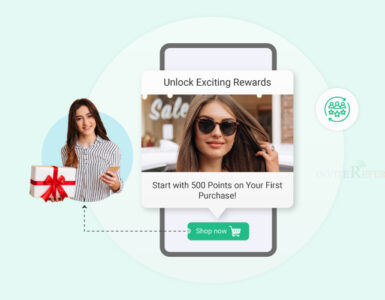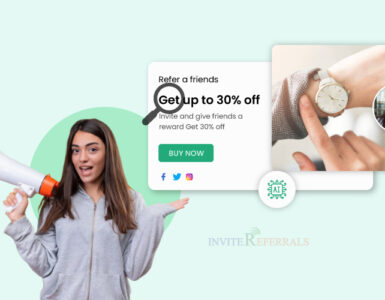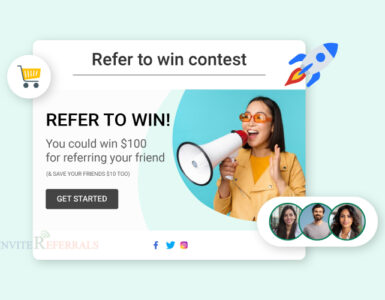Word of mouth is the most trustworthy source of promoting brands. According to the stat, more than 84% of people show trust in family and friends over advertisements or brand representatives.
Our purchasing decisions are influenced by reviews, recommendations, testimonials, social chatter, and, most importantly, referrals. Employing referral marketing helps you to stand out among industry competitors—as long as you do it efficiently.
In this article, we will learn about referral marketing strategies that include referral marketing ideas from businesses that have already used these tactics to enhance their sales.
What are the referral marketing strategies?

Referral marketing is one of the marketing tactics that make recommendations and word of mouth to build a customer base through the networks of its existing customers. Referral marketing can be in many forms, but at its core, it’s a way to prepare the most prominent supporters to help grow the word about your brand. In other words, referral marketing converts your current customers into brand advocates. For leveraging referral marketing it is necessary to have proper referral marketing strategies at the place.
Why does referral marketing work?

Let’s dive in to learn how to create referral marketing strategies, why you need to, how referral creates a difference from any other marketing tactic.
- The word-of-mouth encourages at least 5x more sales than a paid impression.
- Customers gained through word-of-mouth spend 2x more and make 2x as many referrals themselves.
- Referred leads turn 30% more reliable and have a 16% higher lifetime value than leads obtained via other channels.
Word-of-mouth is the traditional way of referral marketing, and they are cost-effective, robust, and trusted. When we have an excellent experience with a brand, product, or service, we’re happy to—and usually do—share it with others.
Start interacting as much as possible with your customer, and you will get an idea about your customer preferences and about what they want to know, what they expect, and what should be your next step. Even brands are using marketing segmentation formulas to make it work.
Using referral marketing for competitive advantage

The figures don’t lie: Testimonials and recommendations are not only effective but also essential if you want to establish your name. Today, Customers actively go looking for reviews, and they can be an important differentiator between two different brands.
The revolution of marketing has made launching and managing a business more accessible than ever before, but that comes with a price: increased and intense competition.
Referrals convert your happy customers into highly convincing cheerleaders. They’ve paid enough money for your product, and if they’re satisfied with it and the ROI they’re getting from it, that’s a great selling point to others.
Let’s learn some referral program examples; these brands have used different and unique strategies to expand their customer base.
#1. Girlfriend Collective launches into a crowded market
Fashion is one of the crowdiest markets. Women’s style is an unusually crowded field. You have to stand out instantly if you need to make it.
Girlfriend Collective is an athleisure e-commerce company that is required to do something that would make them stand out from the others. The company needed to get traction actively and compete with big brands like Lululemon, Adidas, and Nike.
The company started by creating an excellent product: Their leggings and bodysuits are made entirely from recycled plastic drinking bottles under fair-trade.
Next, Girlfriend Collective wanted to get its name out to as many as possible at a minimum cost. The company didn’t want to spend money on conventional marketing as their opponents had done. So it chose to spend its marketing budget by giving away their $80-leggings for free.
On their pre-launch website, customers were aware of Girlfriend’s use of plastic bottles in their leggings and their dedication to fair trade. They informed customers that they were getting a free pair of leggings, but the leggings were also environmentally-friendly, so they were supporting a great cause.
Since they had channelized customers’ emotions, customers who noticed this cause would suggest this brand and even inform them that all their friends would get a pair for free, which also supported environmental and social causes, it created a win-win situation that eventually made this story extremely convincing to share.
This offer was only valid for a few months, which attached an additional push for customers to get it and share it with their friends as quickly as possible. People often add more value to something that has insufficient supply; it also has known scarcity marketing.
In this case, it worked well. The girlfriend’s word-of-mouth marketing approach resulted in 10,000 orders within the first day. The abrupt traffic even crashed their website and the sharing feature on Facebook! It also earned a lot of online coverage from sites.
Today, Girlfriend Collective has a strong social media following of 187k from Instagram and 66k from Facebook. Thanks to their unique referral strategy, the e-commerce company was able to gain a vast customer base and following within such a short time. And at an arguably lower price than it would have cost to use an advertisement agency.
#2. Critical Pass scales with the referral program
The exam preparation industry is becoming a big industry. From physical aids like flashcards to online study material, the industry is revolutionizing. Critical Pass sells flashcards for law school and the multistate bar examination. It’s a battle-tested method to study, learn, and give a quality product at a reasonable price.
The company wanted a way to convince students that their solution was the best one for them. But it had several issues to solve. First, the product’s effectiveness would not result in any repeat sales. Secondly, due to individual variations in studying capacity, there was no solid guarantee of how many marks students would obtain from using their study cards.
Initially, the company used a variety of marketing ways to various degrees of success. But eventually, the team realized that the key to encouraging students to try their flashcards lay in their existing satisfied customers.
The bar examination is difficult, and law students manage to search social media, online forums, and community pages for material that can help them pass.
Critical Pass noticed that since its happy customers were likely to recommend or suggest to their peers and juniors what tools worked for them, a referral program to reward those who shared could work. This program would incentivize—and, as a result, encourage—the sharing process.
Using a personalized link, customers earn $10 for every referral that ends up buying a flashcard set. New customers get a 10% discount. Due to the long preparation duration and stressful nature of the exam, many law students usually get by on a part-time job or student loans. These monetary incentives are helpful for them, so they worked.
The referral program was a huge hit, giving a 24x ROI, and accounts for over 10% of revenue and orders. It is suitable for a system that mostly runs itself.
#3. Hawkers recruit every customer as an influencer
The founders of Hawkers, an e-commerce company selling sunglasses worldwide, started as distributors of a fashionable sunglasses brand Knockaround in their home country, Spain.
The founders assisted Knockaround in achieving their success by giving away sunglasses to buddies on Facebook. The latter had a massive number of friends on the social media platform in return for highlighting the sunglasses in their posts.
But they didn’t feel convinced being distributors and required a brand they could call their own. And so Hawkers Co. was born.
This company managed the same micro-influencer social media marketing strategy that had worked so well for a similar product previously. The founders started with Facebook Ads and micro-influencers, supplying free sunglasses to those with a large social media following. They then stretched it to Instagram, and it was so compelling the social media platform featured them as a successful advertising case study.
Besides giving customers free sunglasses alone, Hawkers eventually generated a referral program that benefited the influencers, their followers, and of course, the company itself.
It gave consumers another big reason to show off cool photos of themselves wearing Hawkers’ products. Now they could earn social currency as well as give their friends a good deal.
Sharing personalized promo codes, every customer was now an influencer and could receive a commission for each sale, while referees got a discount for purchase.
The referral program increased the social sharing aspect, and the word-of-mouth strategy was built, allowing about 90% of revenue to come from social media. The company also currently exceeds USD 70 million in sales every year.
Appreciations to brands like Hawkers Co., the eyewear industry that used to rely heavily on celebrity support, has now been revolutionized. Anyone can become an influencer for their peers through social media and spread the word through referral marketing.
With the apt tools and messaging, referral marketing can be a potent and cost-effective tool for your business.
Here are some things to take note of before you can make it work:
- Make sure your brand message is clear to understand and repeat.
- Build a community around your brand. It’s more than a product and a logo. It’s what it stands for and represents. If your customers identify with those values, they will share your story with others, with or without an incentivized referral program.
- Your customers are your best sellers. They can “refer” to their friends and family without sounding selfish. Their friends are likely to go with a friend’s recommendation rather than some celebrity on a TV screen.
- Make referrals accessible. It should be easy for your customer to share your brand with referral rewards that meet their purchasing behavior—do that, and you’ll have a host of loyal cheerleaders working on your behalf.
Conclusion
In this article, we have seen three wonderful real examples of brands and their unique referral marketing strategies. One size fits all approach does not seem relevant today. Since competition is increasing day by day, it is imperative to use unique methods and procedures for making your brand work. I hope this article helps you understand these strategies with these examples.
Keep learning and experimenting.
















